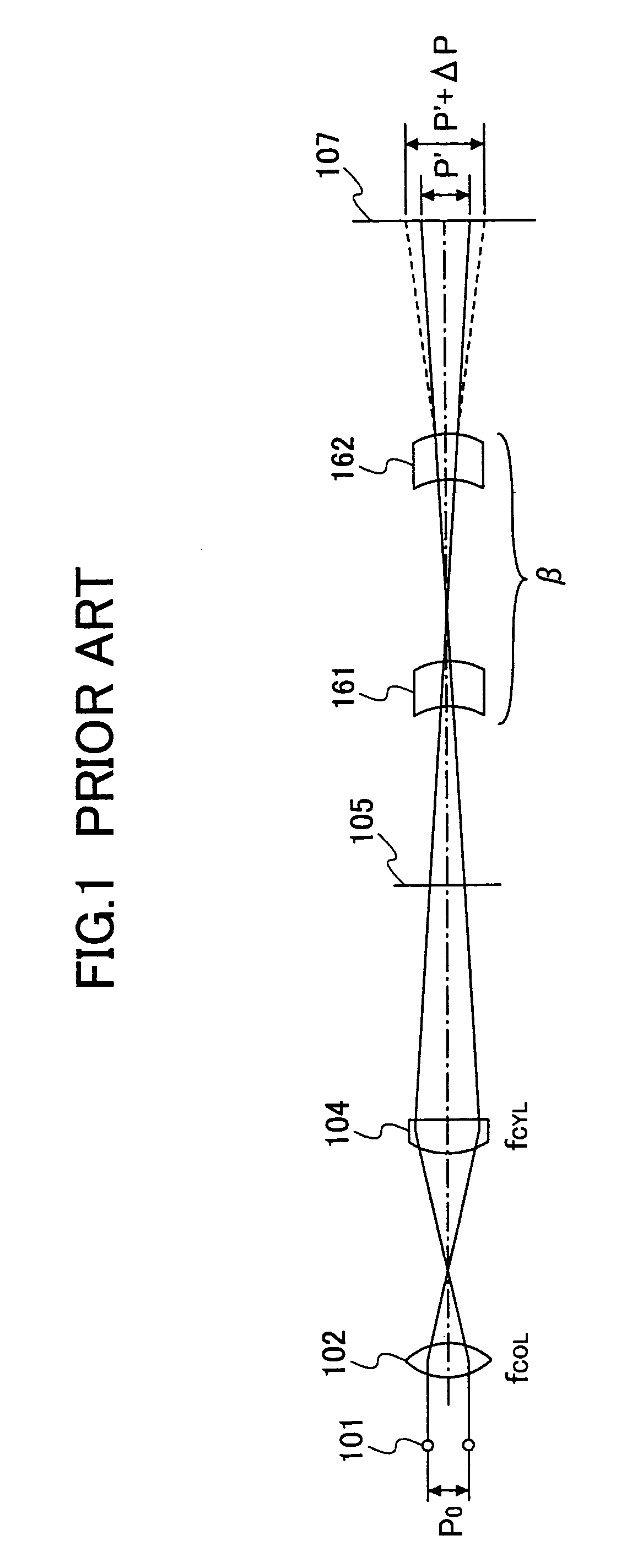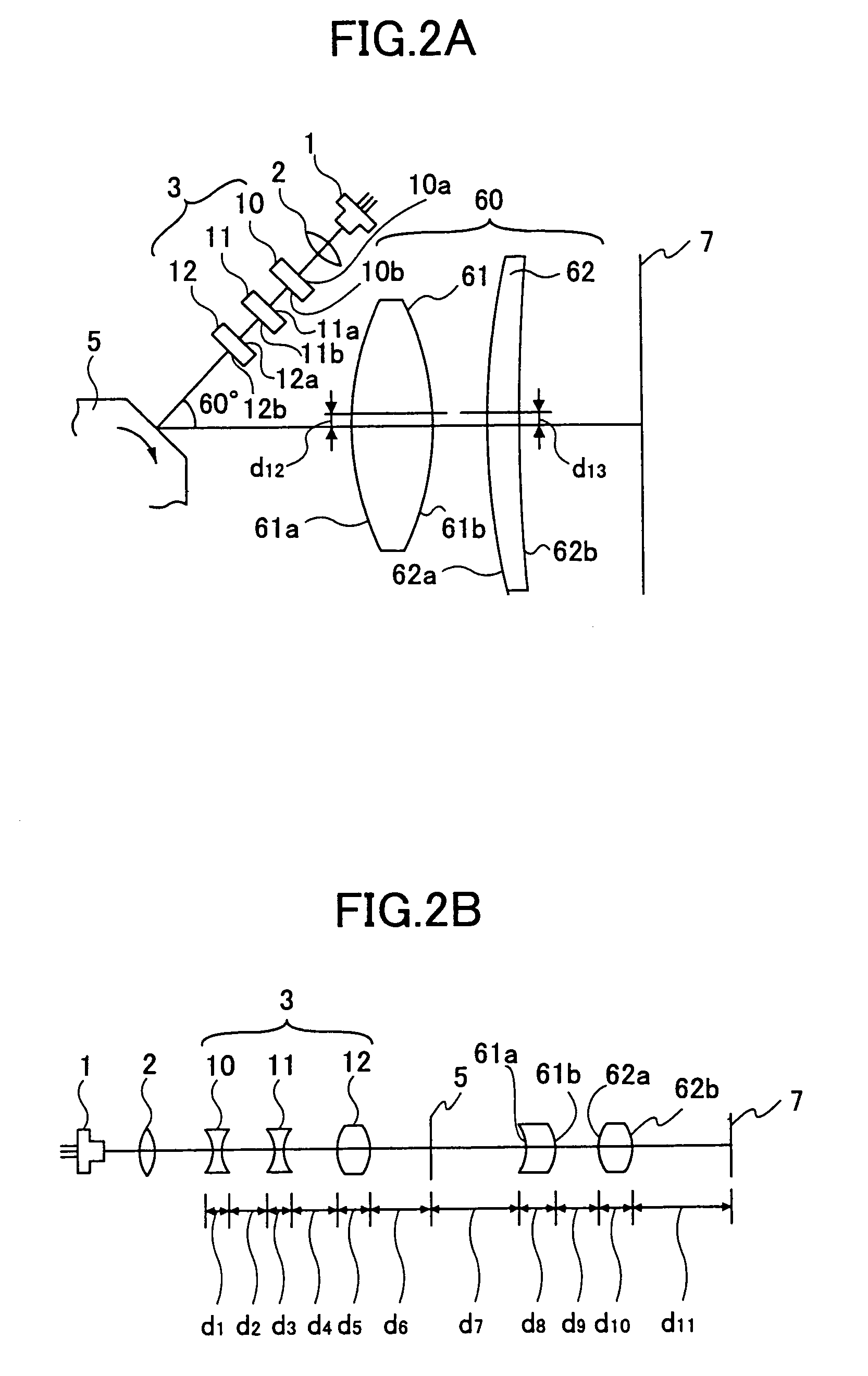Optical scanning device and imaging apparatus implementing the same
a scanning device and optical scanning technology, applied in the field of optical scanning devices and imaging apparatuses, can solve the problems of difficult to realize the above arrangement, the limit of the attempt to increase the recording speed, and the unevenness of the image density
- Summary
- Abstract
- Description
- Claims
- Application Information
AI Technical Summary
Benefits of technology
Problems solved by technology
Method used
Image
Examples
first embodiment
[0070]FIGS. 2A and 2B are diagrams illustrating an optical scanning device according to the present invention, wherein FIG. 2A is a schematic diagram of the optical scanning device, and FIG. 2B is a side view (optical path) diagram of the same optical scanning device. In this embodiment, a plurality of light ray bundles emitted from a light source 1 are coupled into a desired state by means of a coupling lens 2 (first optical system). Herein, the rays are coupled into substantially parallel (or collimated) rays. Also, in this example, a LDA (laser diode array) having a plurality of emission points is used as the light source 1. The light source 1 may also be a plurality of laser diodes that emit multi-beam light synthesized by a prism.
[0071]By using a plurality of light sources as described above, the rotation speed of a light deflector can be lowered, thereby extending the life and reducing the power consumption of the optical scanning device.
[0072]As for the coupling lens 2, a sin...
embodiment 1
[0095](Embodiment 1)
[0096]In the following, the change in the beam pitch in the optical scanning device shown in FIG. 1 obtained from the above formulas describing the surface configurations are given.[0097]‘Light Source’[0098]14 μm-pitch 4-channel LDA[0099]wavelength: 780 nm[0100]slanting angle: 12.39°[0101]‘Coupling Lens’[0102]focal length: 27 mm[0103]coupling effect: collimating effect[0104]‘Polygon Mirror’[0105]number of reflective surfaces: 5[0106]in-circle radius: 18 mm[0107]Angle formed between the incident angle of the beam emitted from the light source and the optical axis of the scanning[0108]optical system: 60°[0109]Write width: +150 mm[0110]Field angle: ±38°[0111]Write density: 1200 dpi[0112]d1=3 mm, d2=9.2 mm, d3=3 mm, d4=8.15 mm, d5=6 mm, d6=114 mm,[0113]Curvature radius of the surface of incidence 10a of the resin lens 10: −119.97 mm (spherical);[0114]Curvature radius of the exit surface 10b of the resin lens 10: ∞ (main scanning) and 16.4 mm (sub scanning);[0115]Curv...
embodiment 2
[0252](Embodiment 2)
[0253]In the following, the change in the beam spot diameter in the optical scanning device shown in FIGS. 5A and 5B obtained from the above formulas describing the surface configurations are given.
[0254]‘Light Source’[0255]14 μm-pitch 4-channel LDA[0256]wavelength: 780 nm[0257]inclination angle: 50.68°[0258]‘Coupling Lens’[0259]focal length: 27 mm[0260]coupling effect: diverging effect[0261]‘Polygon Mirror’[0262]number of reflective surfaces: 5[0263]in-circle radius: 18 mm[0264]Angle formed between the incident angle of the beam emitted from the light source and the optical axis of the scanning optical system: 60°[0265]Write width: ±150 mm[0266]Field angle: ±38°[0267]Write density: 1200 dpi[0268]L1=8 mm, L2=39.4 mm, d1=3 mm, d2=20.35 mm, d3=6 mm, d4=138.5 mm,[0269]Curvature radius of the surface of incidence 13a of the resin lens 13: −135.34 mm (main scanning) and −30 mm (sub scanning);[0270]Curvature radius of the exit surface 13b of the resin lens 13: ∞ (main ...
PUM
 Login to View More
Login to View More Abstract
Description
Claims
Application Information
 Login to View More
Login to View More - R&D
- Intellectual Property
- Life Sciences
- Materials
- Tech Scout
- Unparalleled Data Quality
- Higher Quality Content
- 60% Fewer Hallucinations
Browse by: Latest US Patents, China's latest patents, Technical Efficacy Thesaurus, Application Domain, Technology Topic, Popular Technical Reports.
© 2025 PatSnap. All rights reserved.Legal|Privacy policy|Modern Slavery Act Transparency Statement|Sitemap|About US| Contact US: help@patsnap.com



